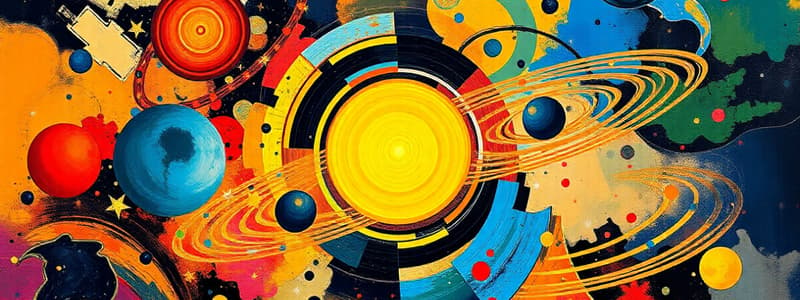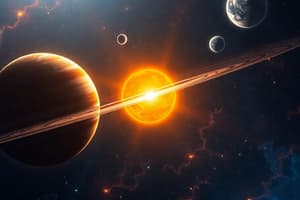Podcast
Questions and Answers
Which planet in the Solar System has the largest volcano?
Which planet in the Solar System has the largest volcano?
- Jupiter
- Venus
- Saturn
- Mars (correct)
Which of these planets is NOT a gas giant?
Which of these planets is NOT a gas giant?
- Jupiter
- Uranus
- Saturn
- Mars (correct)
What is the name of the massive storm on Jupiter that has lasted for centuries?
What is the name of the massive storm on Jupiter that has lasted for centuries?
- The Red Giant
- The Eye of Jupiter
- The Great Red Spot (correct)
- The Jovian Storm
Which planet is known for its unique rotation on its side?
Which planet is known for its unique rotation on its side?
What is the approximate age of the Solar System?
What is the approximate age of the Solar System?
What is the primary component of the rings of Saturn?
What is the primary component of the rings of Saturn?
Which of these is NOT a dwarf planet?
Which of these is NOT a dwarf planet?
What celestial bodies are found primarily in the asteroid belt?
What celestial bodies are found primarily in the asteroid belt?
Which of these planets has the thickest atmosphere of carbon dioxide?
Which of these planets has the thickest atmosphere of carbon dioxide?
What force primarily keeps planets in orbit around the Sun?
What force primarily keeps planets in orbit around the Sun?
Flashcards
Solar System
Solar System
The Sun and all celestial bodies orbiting it, including planets and moons.
Inner rocky planets
Inner rocky planets
The four planets closest to the Sun: Mercury, Venus, Earth, and Mars.
Outer gas giants
Outer gas giants
The four planets far from the Sun: Jupiter, Saturn, Uranus, and Neptune.
Mercury
Mercury
Signup and view all the flashcards
Venus
Venus
Signup and view all the flashcards
Earth
Earth
Signup and view all the flashcards
Mars
Mars
Signup and view all the flashcards
Jupiter
Jupiter
Signup and view all the flashcards
Saturn
Saturn
Signup and view all the flashcards
Gravity
Gravity
Signup and view all the flashcards
Study Notes
Solar System Overview
- The Solar System includes the Sun and all objects orbiting it—planets, moons, asteroids, and comets.
- The Sun, a hot gas ball, provides heat and light.
- Eight planets exist, grouped as inner rocky and outer gas giants.
Inner Rocky Planets
- Mercury is the smallest and closest to the Sun, with extreme temperature variations.
- Venus, similar to Earth in size, has a dense carbon dioxide atmosphere, making it the hottest planet.
- Earth is the only known life-supporting planet, with 71% of its surface covered by water.
- Mars, the Red Planet, holds the largest volcano in the Solar System, Olympus Mons.
Outer Gas Giants
- Jupiter, the largest planet, has a long-lasting storm, the Great Red Spot.
- Saturn is renowned for its prominent ring system, composed of ice and rock.
- Uranus rotates on its side, a unique characteristic among the planets.
- Neptune, the farthest planet, boasts the strongest winds in the Solar System.
Other Solar System Objects
- Asteroids are primarily located in the asteroid belt, between Mars and Jupiter.
- Comets, made of ice and dust, have glowing tails when near the Sun.
- The Kuiper Belt and Oort Cloud are vast regions housing icy bodies and dwarf planets, including Pluto.
Formation and Study
- The Solar System formed roughly 4.6 billion years ago from a gas and dust cloud.
- Scientists use telescopes and spacecraft to study celestial bodies and distant stars.
- Gravity keeps planets in their orbits around the Sun.
Studying That Suits You
Use AI to generate personalized quizzes and flashcards to suit your learning preferences.




